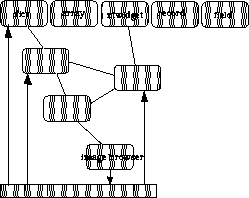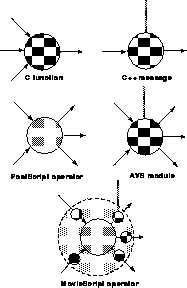




Next: 17.2.7 Integrated Visualization Model
Up: 17.2 System Overview
Previous: 17.2.5 Distributed Computing
Most of the MovieScript components discussed so far, such as Fortran90-style
matrix algebra or communication, are implemented in terms of extended sets of
Postscript types and operators. In the area of data-parallel computing,
based on a finite set of generic operations, the distinction between language
models such as Fortran, C, C++, Lisp, or PostScript is largely a matter of
taste. However, with the growing structural complexity of a given domain,
typically associated with irregular, dynamic computational complexity, both
the compiled imperative languages such as Fortran or C/C++ as well as the
interpreted functional languages such as Lisp of PostScript become
impractical. The best techniques invented so far to handle such complex
problems are provided by the interpretive object-oriented models.
MovieScript extends PostScript by the full object-oriented sector with all
``orthodox'' components such as polymorphism, encapsulation, data abstraction,
dynamic binding, and multiple inheritance. This extension process is
organized structurally in the form of a two-dimensional inheritance
forest which provides a novel design platform for integrating functional
and object-oriented language structures.
All the original PostScript types such as array, string,
dict, and so on. are retained and included in the topmost
``horizontal'' layer of primitive types in MovieScript. This
layer is further extended by new computation, graphics, and
communication primitives. The design objectives of this language
sector are optimized performance, structural simplicity, and enforced
polymorphism of the operator set. The group of primitive types within
the inheritance forest plays the role of the root class in conventional
object-oriented models.
At the same time, the PostScript syntax itself is also extended within
the MovieScript design to support the C++-style, ``true''
object-oriented model with dynamic binding and multiple inheritance.
The derived types, constructed via the inheritance mechanism
starting from the primitive functional types, extend the inheritance
forest in the ``vertical'' direction towards more composite, complex,
and abstract language structures. A finite set of primitive types is
constructed in C and hardwired into the server design. Other primitive
types and all derived types are constructed at run time at the
interpreted level. Some elements of the inheritance forest model are
illustrated in Figure 17.5.

Figure 17.5: Elements of the Inheritance Forest Model. The upper
horizontal axis represents primitive MovieScript types such as dict, array, xtwidget, and so on. The forest of derived
types extends down and follows the multiple inheritance model. Closed
loops in the inheritance network are allowed and resolved by
maintaining only a single copy of a degenerate superinstance. The
figure illustrates the image browser class which can be thought
of as being both a dictionary (of image names) and a widget (such as a
selection list). An instance of a derived type is represented by a
noncontiguous collection of superinstance headers and buffers, with
each buffer maintaining a list of pointers to its superinstance
headers, as illustrated in the figure.
The integration of the PostScript-style functional layer with the C++-style
object-oriented layer, as well as the ``in large'' extensibility model which
defines a suitable balance between both layers, are considered distinctive
features of MovieScript. The idea is to encapsulate the structural
complexity in the form of methods for derived types and to maintain a finite
set of maximally polymorphic operators in the functional sector. The
resulting organization is similar to the way complexity is handled by natural
languages and human practices. The world is described by a large number
of ``things'' (objects, words) and a relatively small number of ``rules''
(polymorphic operators, relations). We could define ``common English'' as a
set of rules and a very restricted subset of objects. The ``expert English''
dialects are constructed by extending the vocabulary by more specialized
and/or abstract objects with complex methods and inheritance patterns. The
process of building expert extensions is graded and consistent with the human
learning process.
Our claim is that the good ``in large'' computer language design should
contain a nontrivial ``common English'' part, useful by itself for a
broad set of generic tasks, and it should offer a graded,
multiscale extensibility model towards specialized
expert dialects. Indeed, we program by building reusable associations
between software entities and names. Each ``in large'' programming
model unavoidably contains a large number of names. The disciplined
and structured process of naming software entities is crucial for
successful complexity control. In languages such as C or Fortran, the
``common English'' part is reduced to arithmetic and simple control
structures such as if, for, switch, and so on. All
other names are simply mapped on a huge and ever-growing linear chain
of library functions. The original language syntax, based on
mathematics notation, degenerates towards a poorly organized functional
programming style. ``In large'' programming in such languages becomes
very complex.
More abstract models such as functional, object-oriented and dataflow
modular programming are more useful, but there are usually some
structure versus function trade-offs in the individual language designs
and the optimal choice for ``in large'' model is all but obvious. A
few examples of various language models are sketched in
Figure 17.6. In our approach, we consider the
object-oriented techniques as the best available tool for building
expert extensions (with the expert knowledge encapsulated in methods)
and the functional model of PostScript as the best way of encoding the
common part of the language. PostScript operators play the role of
rules and Postscript primitive types represent the common vocabulary.
Inheritance forest of MovieScript allows for smooth transition from
common to expert types.

Figure 17.6: Computational Vertices in Various Language Models. Solid arrows
indicate input/output arguments or objects. Wavy lines indicate messages
sent to objects. Dark blobs represent nonsyntactic components of the
language. Light blobs represent polymorphic operators, considered as
syntactic identifiers/keywords. Among the models illustrated in the
figure, we consider MovieScript organization of computational vertices
as most adequate for ``in large'' programming. C, AVS, and PostScript have
a poor encapsulation model. C and C++ are not convenient for dynamic
dataflow programming as they don't offer any universal mechanism for
multiobject/argument output. MovieScript vertices are constructed by
superposition of the C++ style encapsulation model and PostScript-style
multiobject interaction model. Large MovieScript operators are
functionally similar to AVS modules but they follow a multiscale
structural design which enforces software economy and reusability.
The complexity of ``expert English'' is encapsulated in methods for derived
types, and general-purpose functionality of ``common English'' is exposed
in terms of restricted set of polymorphic operators, processing objects
of all granularities. A multiscale language development model, supported
by such organization, is discussed in Section 17.2.8.





Next: 17.2.7 Integrated Visualization Model
Up: 17.2 System Overview
Previous: 17.2.5 Distributed Computing
Guy Robinson
Wed Mar 1 10:19:35 EST 1995






